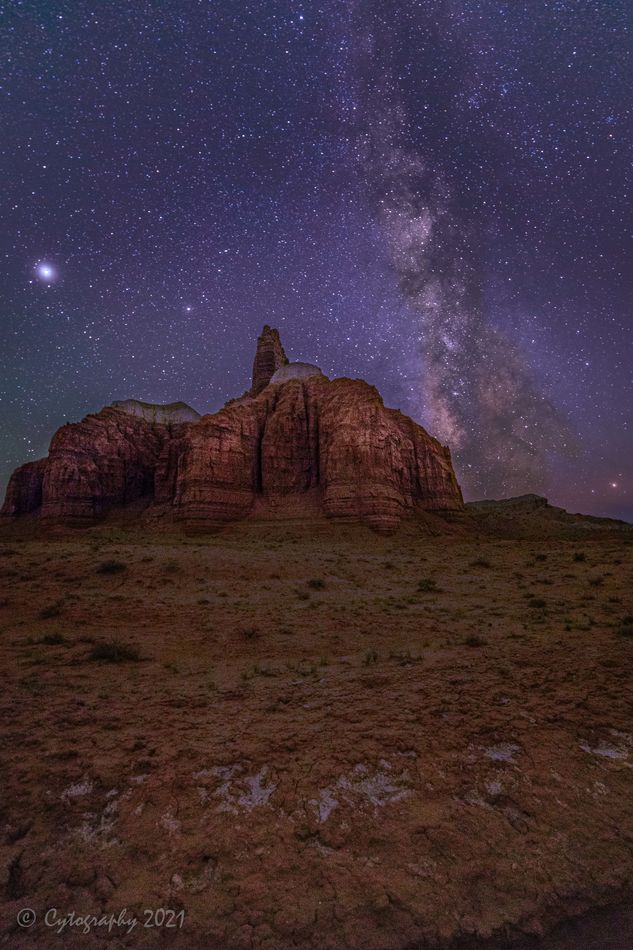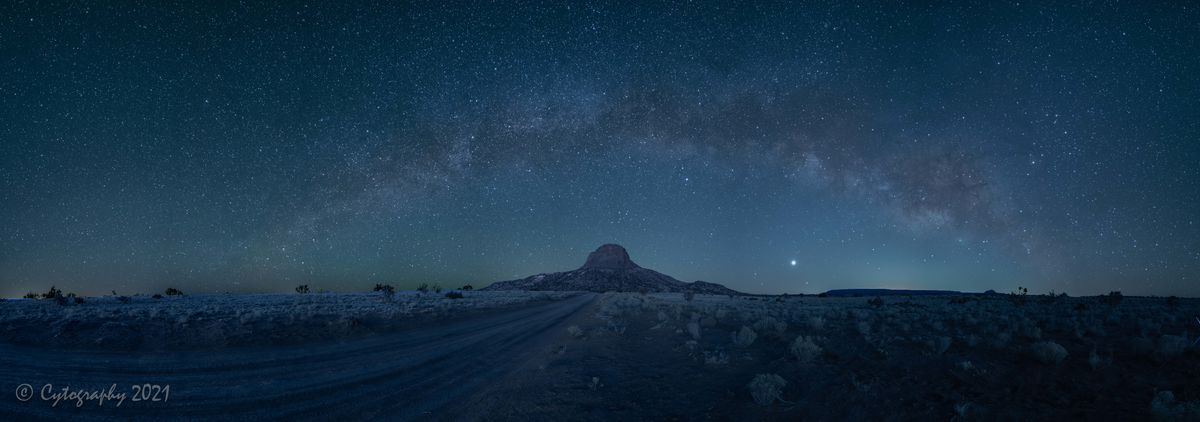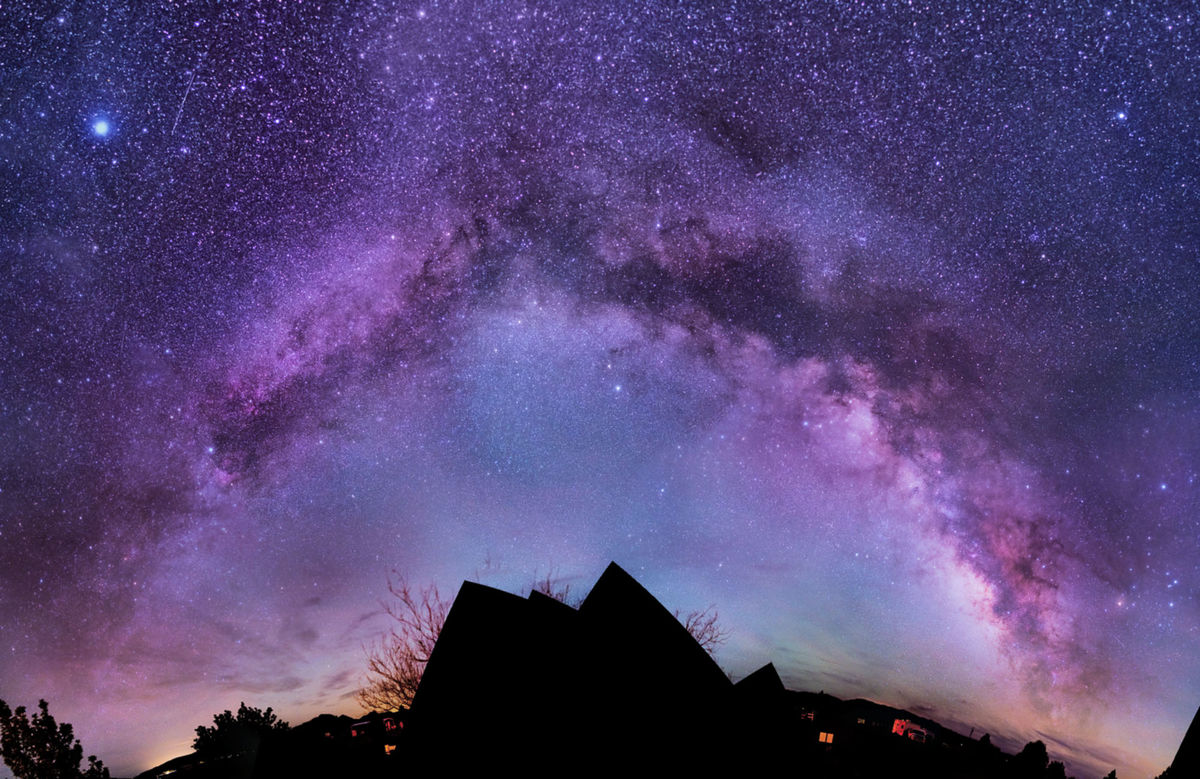Milky way Pano - advice sought
Feb 26, 2022 14:47:26 #
I have successfully shot static single-composition Milky Way shots both with and without a tracker, but I have never tried a pano of the full Milky Way, horizon to horizon. But that's about to change. This week I am planning a trip to a specific location here in New Mexico to shoot (attempt) a Pano of the Milky Way from where it rises in the south to where it sets in the north. I have a specific geological formation that I plan to have pretty much center in the image, with the Mily Way arching across the formation.
I have watched lots of tutorial videos, and have a pretty good general idea of how to approach this shoot, but would love to hear from any UUHers who have some experience shoting panos to hear your thoughts recommendations, things to watch our for etc. So far, this is my general plan:
1. Don't think I want to use a tracker. Instead, I will shoot multiple shots for each "frame" of the pano, then stack them with Starry Landscale Stacker to reduce noice. When I shot the attached image at Goblin State Park, I shot 14mm f2.8 ISO 3200 with 25 seconds per shot. I ended up stacking 20 images that did a nice job of reducing the noise. The 25 second exposure was longer that the NPF rule suggested (18 seconds), but shorter that the 500 rule suggested (36 seconds) and the star trails were practically nil.
Concern - If I shoot that same scenario for a pano, each "frame" (25sec x 20shots) = 500 seconds or a little over 8 minutes per frame. I'm going to shift the camera (right to left) 30 degrees per frame (I'll be shooting portrait orientation). So if each frame takes 8 minutes to shoot 20 shots, and there will be 6 "frames", then the full pano would take 8.3 x 6 = 50 minutes. The sky will have moved nearly 15 degrees by the time I complete the pano. So I know that's way too long to complete the pano due to the movement involved.
If I bump up the ISO to 6400, I think I could shoot at what the default NPF rule says for no star trails, which would be about 18 seconds. If I shoot 10 shots per frame at 18 seconds, then each "frame" would take 180 seconds, or 3 minutes. Then, to get the full pano with 6 frames, that would take 3minutes x 6 frames = 18 minutes. Accounting for time between shots to move the head 30 degrees and start the next frame, I estimate the sky would move about 3-4 degrees from the time I start the pano until I finish.
Question: Should I scrap the idea of multiple shots for each frame and just live with the noise, or would taking 18-20 minutes be ok to complete the pano, or maybe reduce the number of shots to some lesser number (5 or 6 per frame) so I could still use Starry Landscape stacker? Is there a "maximum" time to allow for taking the entire pano north-to-south? Any other ideas, thoughts advice?
Here is a single frame Milky Way shot I did last October. This was done by stacking 20 shots that were 25 seconds each. I was pleased with the final result and would like to get close to this for a pano, but I know that I can't take 18-20 minutes to complete the pano.
Another Question: Would it be better to start the pano to the south (where the Core will be just above horizon) and shoot south to north, or would it be better to start north and go to the south?
I have watched lots of tutorial videos, and have a pretty good general idea of how to approach this shoot, but would love to hear from any UUHers who have some experience shoting panos to hear your thoughts recommendations, things to watch our for etc. So far, this is my general plan:
1. Don't think I want to use a tracker. Instead, I will shoot multiple shots for each "frame" of the pano, then stack them with Starry Landscale Stacker to reduce noice. When I shot the attached image at Goblin State Park, I shot 14mm f2.8 ISO 3200 with 25 seconds per shot. I ended up stacking 20 images that did a nice job of reducing the noise. The 25 second exposure was longer that the NPF rule suggested (18 seconds), but shorter that the 500 rule suggested (36 seconds) and the star trails were practically nil.
Concern - If I shoot that same scenario for a pano, each "frame" (25sec x 20shots) = 500 seconds or a little over 8 minutes per frame. I'm going to shift the camera (right to left) 30 degrees per frame (I'll be shooting portrait orientation). So if each frame takes 8 minutes to shoot 20 shots, and there will be 6 "frames", then the full pano would take 8.3 x 6 = 50 minutes. The sky will have moved nearly 15 degrees by the time I complete the pano. So I know that's way too long to complete the pano due to the movement involved.
If I bump up the ISO to 6400, I think I could shoot at what the default NPF rule says for no star trails, which would be about 18 seconds. If I shoot 10 shots per frame at 18 seconds, then each "frame" would take 180 seconds, or 3 minutes. Then, to get the full pano with 6 frames, that would take 3minutes x 6 frames = 18 minutes. Accounting for time between shots to move the head 30 degrees and start the next frame, I estimate the sky would move about 3-4 degrees from the time I start the pano until I finish.
Question: Should I scrap the idea of multiple shots for each frame and just live with the noise, or would taking 18-20 minutes be ok to complete the pano, or maybe reduce the number of shots to some lesser number (5 or 6 per frame) so I could still use Starry Landscape stacker? Is there a "maximum" time to allow for taking the entire pano north-to-south? Any other ideas, thoughts advice?
Here is a single frame Milky Way shot I did last October. This was done by stacking 20 shots that were 25 seconds each. I was pleased with the final result and would like to get close to this for a pano, but I know that I can't take 18-20 minutes to complete the pano.
Another Question: Would it be better to start the pano to the south (where the Core will be just above horizon) and shoot south to north, or would it be better to start north and go to the south?

Feb 26, 2022 14:57:52 #
Consider doing it both ways as the non stacked option will only add a few minutes to your outing.
I hope to try some milky way shots myself so am eager to see what other UHH folks advise.
The shot you posted is very nice, it would be hanging on my wall if I got one thar well done.
I hope to try some milky way shots myself so am eager to see what other UHH folks advise.
The shot you posted is very nice, it would be hanging on my wall if I got one thar well done.
Feb 26, 2022 16:25:17 #
BassmanBruce wrote:
Consider doing it both ways as the non stacked option will only add a few minutes to your outing.
I hope to try some milky way shots myself so am eager to see what other UHH folks advise.
The shot you posted is very nice, it would be hanging on my wall if I got one thar well done.
I hope to try some milky way shots myself so am eager to see what other UHH folks advise.
The shot you posted is very nice, it would be hanging on my wall if I got one thar well done.
That's not a good idea (why didn't I think if that). If I start early enough I could try single shot frames, then maybe a set with 5 shots per, 10 shots per (that's probably as many as feasible to try).
Feb 26, 2022 19:24:17 #
PoppieJ
Loc: North Georgia
i would turn my camera landscape, shoot the sky tracked at about 2 minutes with a 6400 ISO. you should be able to do the whole thing in 3 shots. Then I would go back and do the foreground with a low ISO and take all the time you need for it. With the long exposure for the sky you should not have much if any noise.
Feb 26, 2022 22:20:43 #
BassmanBruce wrote:
Consider doing it both ways as the non stacked option will only add a few minutes to your outing.
I hope to try some milky way shots myself so am eager to see what other UHH folks advise.
The shot you posted is very nice, it would be hanging on my wall if I got one thar well done.
I hope to try some milky way shots myself so am eager to see what other UHH folks advise.
The shot you posted is very nice, it would be hanging on my wall if I got one thar well done.
In my previous reply I said "That's not a good idea." I think I was thinking of "That's a good idea" and "that's not a bad idea" and had a senior moment.
I meant, that IS a GOOD idea.
Feb 26, 2022 22:41:11 #
Basil wrote:
In my previous reply I said "That's not a good idea." I think I was thinking of "That's a good idea" and "that's not a bad idea" and had a senior moment.
I meant, that IS a GOOD idea.
I meant, that IS a GOOD idea.
Saw that right off, ain’t being a senior Grand!!



Feb 27, 2022 01:27:58 #
BassmanBruce wrote:
Saw that right off, ain’t being a senior Grand!! 





Tell me about it! Can't tell you how many times I've walked, with much sense of purpose and deliberation, into the kitchen, only to ask myself, once there: "why did I come in here?"
Feb 27, 2022 08:26:34 #
Feb 27, 2022 11:31:04 #
slcarn
Loc: Draper, Utah USA
Basil wrote:
Tell me about it! Can't tell you how many times I've walked, with much sense of purpose and deliberation, into the kitchen, only to ask myself, once there: "why did I come in here?"
Food, always food! :) :) :)
Feb 27, 2022 18:07:11 #
Basil wrote:
I have successfully shot static single-composition... (show quote)
I shot and processed an horizon to horizon Milky Way pano in Rodeo, New Mexico in April 2014. The pano was prepared from single images taken with a 35mm lens on a Sony A7R, 10 sec., ISO 3200.
Clear skies!
bwa
Feb 28, 2022 12:19:51 #
Ballard
Loc: Grass Valley, California
Basil wrote:
I have successfully shot static single-composition... (show quote)
I have noticed that even the best lens will have some coma at the corners of the image when wide open. Therefor I would recommend that you have a fair amount of overlap in the shots to be able to crop out the corners of each image and still have enough overlap to create the Pano.
Feb 28, 2022 14:21:36 #
Ballard wrote:
I have noticed that even the best lens will have some coma at the corners of the image when wide open. Therefor I would recommend that you have a fair amount of overlap in the shots to be able to crop out the corners of each image and still have enough overlap to create the Pano.



Or if you're using a full frame sensor, shoot in crop mode.
bwa
Mar 2, 2022 17:38:43 #
Well, here is my first attempt at a Milky Way Pano. This was shot starting around 4:15AM (Mountain time) this morning. There are 13 "frames" in the pano. Each frame shot was comprised of 5 images that were 18 second exposures each (stacked in Starry Landscape stacker). 14mm f2.8 ISO 6400. Foreground shot from same location but during blue hour.

Mar 2, 2022 18:55:18 #
Basil wrote:
Well, here is my first attempt at a Milky Way Pano. This was shot starting around 4:15AM (Mountain time) this morning. There are 13 "frames" in the pano. Each frame shot was comprised of 5 images that were 18 second exposures each (stacked in Starry Landscape stacker). 14mm f2.8 ISO 6400. Foreground shot from same location but during blue hour.
Excellent start. Your sky is ideal for a great Milky Way!
bwa
If you want to reply, then register here. Registration is free and your account is created instantly, so you can post right away.


